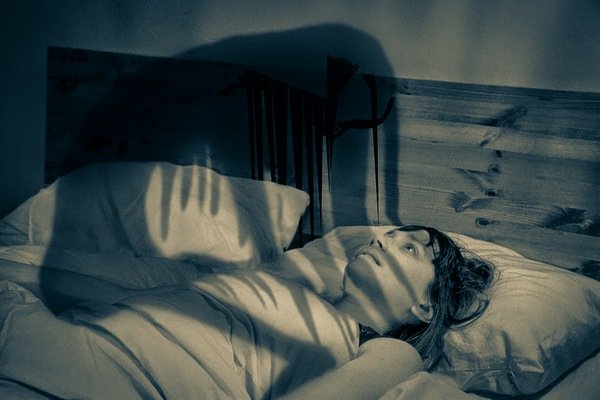Do You Get Pressed In The Midnight? Check This 11 Facts About Sleep Paralysis You Need To Know + Gifs
to which one is unable to react due to paralysis and perceived physical
experiences, such as a strong current running through the upper body.
Sleep paralysis poses no immediate risk to those who experience it, and it lasts from several seconds to several minutes.
1.
It feels kind of like you woke up dead.
“Most patients say the same thing to describe sleep paralysis: that
it feels like you woke up dead. You know that your mind is awake and
your body is not — so you’re trapped, essentially,” Michael Breus,
Ph.D., clinical psychologist and fellow of the American Academy of Sleep
Medicine, tells BuzzFeed Life.
2.
And it’s way more complicated than a nightmare.
 “It is the complete opposite, actually,” Breus explains. When you
“It is the complete opposite, actually,” Breus explains. When you
enter deep REM sleep, your brain tells the body’s voluntary muscles to
relax and go into almost a state of paralysis, which is called atonia.
Atonia actually helps protect the body from injury by preventing you
from acting out the physical movements in your dreams. In other
parasomnias, such as sleepwalking or REM sleep behavior disorder,
atonia does not occur properly and the voluntary muscles move while the
mind remains asleep, which is why people can sometimes do crazy things in their sleep and be totally unaware of it.
In
sleep paralysis, the body remains paralyzed in REM atonia while the
brain awakens and the eyes start to open, explains Breus. Sufferers
become alert in a transient conscious state, but they are unable to move
voluntary muscles or speak. Although involuntary muscle movement, like
breathing, is not affected, there is often a sensation of chest
pressure, which is why many people wake up from sleep paralysis gasping
to take a deep breath. Episodes can last anywhere from 20 seconds to a
few minutes.
3.
It happens when you’re falling asleep or waking up.
Sleep paralysis can occur during one of two transitions in the
sleep cycle. The body must go into REM sleep, and it must come out of
it, but sleep paralysis occurs when the body has trouble making these
transitions. If it happens when you’re falling asleep, it’s called
hypnagogic sleep paralysis, whereas if it happens during waking it’s
called hypnopompic, Breus explains. Unfortunately, why the body can’t transition smoothly is still unknown.
4.
Sleep paralysis can involve hallucinations.

Unlike the visuals in nightmares or lucid dreams, which occur when the eyes are closed in REM sleep, these hallucinations
occur in the state between sleeping and waking when the mind is alert
and the eyes are open. True visual and auditory hallucinations during
sleep paralysis are relatively rare, according to Breus, but many
patients report feeling an undeniably strange or scary presence in the
room.
Plus, sleep paralysis is just super frightening to begin
with, so it often triggers a panicked response with increased heart
rate. “People freak out because they can’t move, and it’s this extreme
anxiety which causes people to be very fearful of their surroundings,”
says Breus.
5.
You can’t just wake yourself up.
Some patients report that they can wiggle their toes, fingers, or
facial muscles, which helps them wake up the rest of their body.
“Everybody tries something different, but you can’t fool mother nature
— there’s no way to pull yourself out of it. You just have to wait it
out,” says Breus.
6.
Sleep paralysis is actually a natural occurrence and can happen to anyone.
 Every time you go to sleep, there is some risk of waking up in
Every time you go to sleep, there is some risk of waking up in
sleep paralysis, says Breus. But severity and degree of consciousness
vary greatly — most people have at least one episode at some point in
life but aren’t even aware of it. When it does happen, it’s highly
individual and rarely the same experience for everyone.
A Penn State study found the highest prevalence rates were in students and psychiatric patients.
7.
It’s probably related to being sleep deprived.
According to Breus, research has consistently shown that the less
sleep you get and the more exhausted you are, the more likely you are to
experience sleep paralysis and other sleep disorders.
8.
So avoiding sleep paralysis might be as simple as getting better and longer sleep.
 “Sleep deprivation can either be measured in quantity or quality,”
“Sleep deprivation can either be measured in quantity or quality,”
says Breus. “For example, if you have sleep apnea and you wake yourself
up because you stop breathing throughout the night, the quantity of your
sleep is bad. If you consume large amounts of alcohol, it prevents you
from entering deeper stages of sleep which decreases the quality.”
So
if sleep paralysis is something you deal with, make sure you’re getting
enough sleep and you’re not doing things that compromise the quality of
your sleep (like drinking a lot or eating right before bed). Breus also
suggests noting any abnormal sleep behaviors (that you or your partner
may notice), like irregular breathing while sleeping or waking up
gasping for air, which could actually be an undiagnosed sleep disorder.
9.
But really, there is no definitive cause.
Stress, depression, certain prescription medications, and, more recently, an inherited gene have all been linked to sleep paralysis, Breus tells us. But while research shows associations, there is no clear cause of sleep paralysis, which is obviously super frustrating for anyone going through this.
We
do know that sleep paralysis can either occur on its own as an isolated
incident, or it can be a symptom of other sleep disorders, such as
narcolepsy. And there’s no explanation for why it might happen every
other day or just every once in a while.
10.
Seriously, people have been trying to explain this weird phenomenon for centuries.

Accounts of sleep paralysis can be found in Persian medical texts dating back to the 10th century.
The first clinical observation was made by a Dutch physician in 1664
who diagnosed a 50-year-old woman with “Night-Mare.” It was believed to
be caused by demons or spiritual possession until the 19th century, when
it was termed “sleep palsy” and eventually “sleep paralysis” in medical
texts.
11.
And it probably explains whatever is going on in this very famous Renaissance painting.
 Swiss painter Henry Fuseli’s painting is said to be inspired
Swiss painter Henry Fuseli’s painting is said to be inspired
by supernatural dream experiences and the growing interest in sleep
paralysis among doctors at the time. This creepy little gremlin could
also represent the sensation of chest pressure…or it could be argued
that he’s just trying to get it in with this sleeping damsel
12.
People have blamed sleep paralysis on everything from witches and UFOs to giant ghost dogs.
13.
However, there’s really no evidence that it’ll kill you.
 “Research has shown that sleep paralysis is not dangerous,” says
“Research has shown that sleep paralysis is not dangerous,” says
Breus. “It does not cause physical harm to the body and there are no
clinical deaths known to date.” While there are some terrifying cultural
explanations around the world, these are constructed to make sense of a
very mysterious condition.
“The biggest thing is to educate
people to not be afraid,” says Breus. “In all likelihood, they just need
more rest. If they get enough sleep and the episodes continue with any
regularity, then they should go to a sleep disorder specialist.”
…But just try telling that to someone who has sleep paralysis.

Anyone who has ever experienced this can tell you that it is effing
terrifying and feels almost paranormal, rather than a typical sleep
disorder. Sufferers share their frightening experiences in countless YouTube videos, Reddit threads, and sleep paralysis websites.
SOURCE: buzzfeed.com








